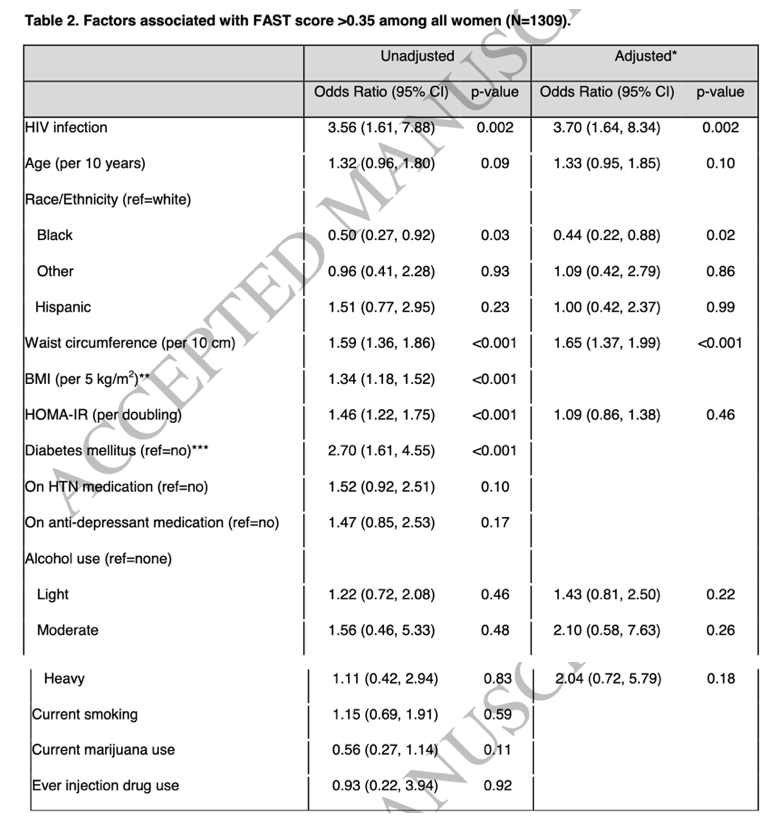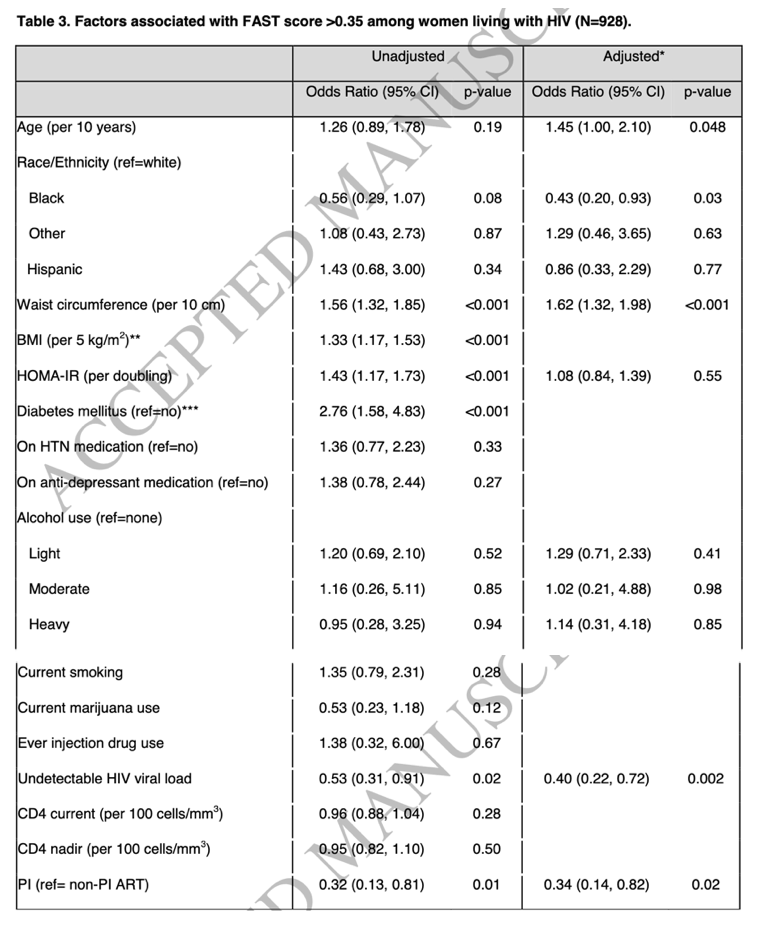| |
HIV is associated with elevated FibroScan-AST (FAST) score
|
| |
| |
Download the PDF here
Authors Conclude:
In the largest study to date of VCTE in WLWH and a comparison group of WLWOH with similar sociodemographic and metabolic risk factors for NAFLD, we found that HIV infection is associated with 3.7-fold higher odds of elevated FAST scores, even after adjustment for sociodemographic, behavioral, and metabolic factors. As expected, greater waist circumference, a marker of visceral obesity, was also strongly associated with elevated FAST. The use of a non-invasive measure that can serve as a surrogate for histologic findings that are associated with significantly higher risk of developing cirrhosis and end-stage liver disease23 is greatly needed in PLWH. However, our finding that the association of HIV infection with elevated FAST was mainly driven by the AST component of the score indicates that further investigation of FAST and other non-invasive measures in the setting of HIV is warranted.
In table 3 below you can see factors associated with FAST score in PLWH and they include of note: diabetes, BMI, waist circumference.

Clinical Infectious Diseases 03 May 2022
Jennifer C. Price1, Yifei Ma1, Mark H. Kuniholm2, Adaora A. Adimora3, Margaret Fischl4, Audrey3 L. French5, Elizabeth T. Golub6, Deborah Konkle-Parker7,Howard Minkoff8, Ighovwerha4 Ofotokun9, Michael Plankey10, Anjali Sharma11, Phyllis C. Tien1,12
Abstract
Background & Aims
Whether HIV infection is associated with the development of nonalcoholic steatohepatitis (NASH) remains unclear. The FibroScan-AST (FAST) score was developed to identify patients who have histologic NASH with high nonalcoholic fatty liver disease activity score (NAS≥4) and significant liver fibrosis (≥F2), which has been associated with higher risk of end-stage liver disease. We examined whether HIV infection is associated with elevated FAST score in a large United States (US) cohort.
The FAST score incorporates the two measurements obtained by vibration controlled transient elastography (VCTE), liver stiffness (LS) and controlled attenuation parameter (CAP), combined with aspartate aminotransferase (AST).
The Women's Interagency HIV Study (WIHS, now part of the MACS-WIHS Combined Cohort Study14) was a multicenter prospective cohort study established in 1994 to investigate the course of HIV and associated conditions among women living with and without HIV. A total of 4,982 women (3,678 with HIV and 1,304 without HIV) were enrolled from 10 study sites in the13
US during 4 recruitment waves.15 Starting in 2013, women age 35 years and older from the Atlanta, Birmingham/Jackson, Bronx, Brooklyn, Chapel Hill, Chicago, Miami, San Francisco, and Washington DC sites were enrolled
Approach
Vibration controlled transient elastography was performed in 1309 women without history of chronic viral hepatitis enrolled from 10 US sites: 928 women living with HIV (WLWH) and 381 women living without HIV (WLWOH). We used multivariable logistic regression to evaluate associations of HIV, demographic, lifestyle, and metabolic factors with an elevated (>0.35) FAST score.
The majority of participants were Black (74%), and race/ethnicity did not differ by serostatus. WLWOH reported more alcohol, smoking and marijuana use and were more likely to have ever used injection drugs than WLWH (all p<0.05). Median BMI and waist circumference were similar regardless of HIV serostatus, but WLWH had higher median HOMA-IR compared to WLWOH (2.1 vs. 1.8; p=0.047).
Results
Median age of WLWH and WLWOH was 51 years and 48 years, respectively. Most (90%) WLWH were on antiretroviral therapy and 72% had undetectable HIV RNA. Prevalence of elevated FAST score was higher among WLWH compared to WLWOH, 6.3% vs 1.8% (p=0.001). On multivariable analysis, HIV infection was associated with 3.7-fold higher odds of elevated FAST score (p=0.002) and greater waist circumference (per 10 cm) was associated with 1.7-fold higher odds (p<0.001). In analysis limited to WLWH, undetectable HIV RNA and current protease inhibitor use were independently associated with lower odds of elevated FAST score.
Median CAP was 247 dB/m in WLWH (IQR 209, 290) and 249 dB/m in WLWOH (IQR 206, 283). Median LS was also similar and did not differ by serostatus: 5.1 kPa in WLWH (IQR 3.9, 6.7) and 4.9 kPa in WLWOH (IQR 3.9, 6.2). By contrast, median AST and ALT levels were higher in the WLWH compared to the WLWOH, but median values were in the normal range (<20 U/L). Most WLWH were taking ART (90%), with undetectable HIV RNA (72%), and 48% were on an integrase strand transfer inhibitor (INSTI) containing regimen (Table 1). Specific antiviral therapy medications for the WLWH can be found in Supplemental Table 1.
Conclusions
Our findings suggest that HIV is an independent risk factor for NASH with significant activity and fibrosis. Studies validating FAST score in persons living with HIV are warranted.
Nonalcoholic fatty liver disease (NAFLD) is a world-wide epidemic with an estimated global prevalence of 25%.1 NAFLD encompasses a spectrum from simple steatosis to nonalcoholic steatohepatitis (NASH), which is characterized histologically by steatosis with inflammation and hepatocyte ballooning, with or without fibrosis.2 Approximately 20% of individuals with NAFLD
have NASH, which can progress to cirrhosis, hepatocellular carcinoma, and end-stage liver failure.3 NAFLD is common among persons living with HIV (PLWH).4 Moreover, non-viral liver diseases, including NASH, have surpassed viral hepatitis-associated liver disease as the leading indications for liver transplant among PLWH.5 HIV has numerous inflammatory effects on the liver and accelerates the natural history of chronic hepatitis C virus (HCV) and hepatitis B virus (HBV) infections.6-11 Evidence suggests that HIV infection may be similarly associated with the more severe form of NAFLD. For example, a meta-analysis including studies of PLWH without viral hepatitis coinfection and with abnormal ultrasound or elevated liver enzymes found a high prevalence of NASH (42%) and significant fibrosis (22%) on liver biopsy.12 However, it remains unclear whether HIV infection is independently associated with NASH because prospective histology studies have lacked HIV-seronegative controls.
Association of HIV infection with components of FAST score
To understand how the components of the FAST score may influence the relationship of HIV with elevated FAST, we evaluated unadjusted and adjusted associations of HIV serostatus with CAP, LS, AST, and FAST modelled continuously. On univariable analysis, HIV was associated with 0.5% higher CAP and 4.2% higher LS but this was not statistically significant with p=0.75221
and p=0.116, respectively. HIV was associated with significantly higher AST (13% higher, p<0.001), and FAST score (43% higher, p<0.001). In multivariable models adjusted for demographic, behavioral, and metabolic factors, these associations remained similar with HIV associated with 0.1% higher CAP (p=0.951), 3.8% higher LS (p=0.144), 13% higher AST (<0.001), and 42% higher FAST score (p<0.001). We next used separate path analysis to assess the individual contributions of AST, LS, or CAP to the association of HIV with FAST score. In the path analysis where AST was a mediator between HIV and FAST score, the indirect effect of AST explained 98% of the total effect between HIV and FAST score and the direct effect explained only 2%; LS explained 14% of the total effect, and CAP explained 2% of the total effect.


|
|
| |
| |
|
|
|